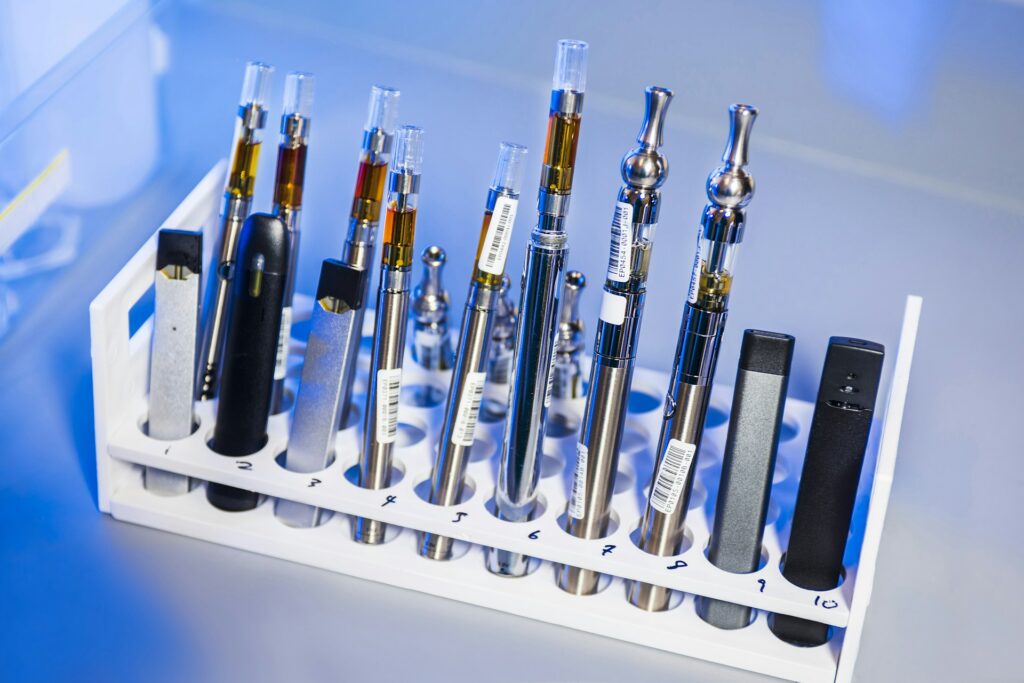Recent research by the American Chemical Society indicates that vape pens used for cannabis vaporization may contain toxic metal nanoparticles, including lead, posing serious health risks, particularly from products on the black market. The study calls for greater regulation and further investigation to ensure the safety of cannabis vaporization products and protect public health.
Cannabis Vape Pens May Contain Lead and Other Toxic Metals


Vape pens have become a popular alternative to traditional cannabis consumption methods, often touted as a safer option. However, a growing body of research points to new risks associated with using vape pens. Recent studies by the American Chemical Society have revealed the presence of toxic metal nanoparticles in cannabis vaporizer liquids even before their first use, especially in black market products, which could have serious public health consequences.
For more news like this, along with all the latest in legalization, research, and lifestyle, download our free cannabis news app.
Cannabis Vape Pens Study Background
The vape pens study presented at the American Chemical Society (ACS) spring conference in New Orleans on March 19, 2024, sheds light on the potential dangers associated with vaporizing cannabis using vape pens. While the legalization and regulation of cannabis for adults are progressing in many places, including Canada, vaporization products are relatively new and there is still a lack of data on their safety.
Andrew Waye, leading the research program at the Office of Cannabis Science and Surveillance at Health Canada, emphasizes the importance of investigating unresolved safety issues of these products.
Research Methodology
For the study, a team led by Andrew Waye, in collaboration with Zuzana Gajdosechova from the Metrology Research Centre National Research Council of Canada, collected 41 samples of cannabis vaporizer liquids for use in vape pens. These samples came from both legal sources (Ontario Cannabis Store) and the illegal market (provided by Ontario Provincial Police). Mass spectrometry and scanning electron microscopy were used to analyze the metal content, providing visual confirmation of the presence of metal particles.
Vape Pens Study Findings
The analysis revealed the presence of 12 different metals in the tested vape pens liquids. Some of these, such as arsenic, mercury, and cadmium, were within tolerance limits for cannabis products. However, others – particularly lead – were present at concentrations significantly exceeding permissible levels, especially in products from the unregulated market. Importantly, metal contamination was found in liquids that had never been used, suggesting that it originates from the manufacturing devices themselves.
“Evidence strongly suggests that metal contamination may come from the device during its production, not from heating coils,” explains Gajdosechova.
The presence of toxic metals in vape pen liquids, especially highly reactive nanoparticles, can pose a serious risk to users’ health. These metals can be transferred to the aerosol during vaporization and enter the user’s lungs, raising concerns about potential long-term effects.
The Role of Regulation and Future Research Directions
The vape pens study highlights the importance of regulation in ensuring the safety of cannabis vaporization products. Regulations can help eliminate metal contaminants at the production stage and ensure uniformity and quality control of finished products. The research team plans further studies to understand how metal nanoparticles can be transferred to the aerosol and what the health consequences for users might be.
Although vape pens are often presented as a safer alternative to smoking, findings on the presence of toxic metals in cannabis vaporizer liquids underscore the need for further research and regulation. It’s a reminder that both consumers and regulators must remain vigilant about the potential risks associated with new cannabis products.
—
(Featured image by CDC via Unsplash)
DISCLAIMER: This article was written by a third-party contributor and does not reflect the opinion of Hemp.im, its management, staff, or its associates. Please review our disclaimer for more information.
This article may include forward-looking statements. These forward-looking statements generally are identified by the words “believe,” “project,” “estimate,” “become,” “plan,” “will,” and similar expressions. These forward-looking statements involve known and unknown risks as well as uncertainties, including those discussed in the following cautionary statements and elsewhere in this article and on this site. Although the company may believe that its expectations are based on reasonable assumptions, the actual results that the company may achieve may differ materially from any forward-looking statements, which reflect the opinions of the management of the company only as of the date hereof. Additionally, please make sure to read these important disclosures.
First published in Fakty Konopne, a third-party contributor translated and adapted the article from the original. In case of discrepancy, the original will prevail.
Although we made reasonable efforts to provide accurate translations, some parts may be incorrect. Hemp.im assumes no responsibility for errors, omissions or ambiguities in the translations provided on this website. Any person or entity relying on translated content does so at their own risk. Hemp.im is not responsible for losses caused by such reliance on the accuracy or reliability of translated information. If you wish to report an error or inaccuracy in the translation, we encourage you to contact us.



Comments are closed for this post.